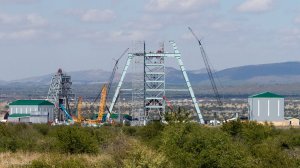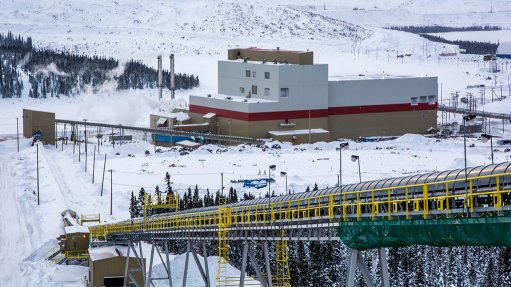EIA regulation amendments promotes integration


SMOOTHER LICENSING PROCESS Mine design, site selection and infrastructure layouts should be identified before commencing environmental permitting
Photo by Duane Daws
The amendments to the Environmental Impact Assessment (EIA) Regulations under the National Environmental Management Act, which came into effect in December last year, supports the early integration of social and environmental aspects into mining project design, says consulting engineers and scientists, SRK Consulting.
SRK Consulting partner Briony Liber tells Mining Weekly that this will promote the identification and management of social and environmental risks before an environmental licence application for a mining project is submitted to the Department of Mineral Resources (DMR).
The amendments will also enable mining companies to identify and design out material impacts early on when it is still easier to do so, with the aim of avoiding or minimising impacts where possible rather than managing impact later on. ”SRK encourages mining companies to compile early baseline data collection and specialist investigations that inform prefeasibility and feasibility decisions and not just permitting,” says Liber.
SRK Consulting principal environmental scientist Franciska Lake states that it is important that mine design, site selection and infrastructure layouts, are fixed before commencing environmental permitting to ensure a smooth licencing process.
Liber suggests that mining developers should work well ahead of the 300-day permitting timelines by consulting with regulators, stakeholders, and interested and affected communities. This allows mine developers to establish constructive relationships that will provide input opportunities into the mine design, resulting in a final design, which all parties are familiar with, being submitted for permitting, limiting any delays during the permitting process.
She notes that depending on the nature and scale of a project, the period ahead of the 300-day permitting process may be months to years, adding that sufficient time is needed if seasonal baseline data is to be collected before environmental permitting application is submitted.
“Where baseline data influences project design and infrastructure location, it is advisable to involve environmental assessment practitioners as early as the project concept phase,” Lake suggests, noting that this could be as early as four years before submitting a permitting application, as the project definition often evolves and changes during the various stages of a project before being fixed in the feasibility stage.
She points out that under the previous regulations development of a project description and an EIA would take place at the same time, often resulting in the EIA process being drawn out, because specialist studies and stakeholder engagement would need to be reworked, as a result of infrastructure and project activities changing.
However, the new regulations make it clear that the project description and all relevant EIAs need to be completed before submitting an environmental application, as 300-days is insufficient to accommodate any major changes to the project description.
Meanwhile, SRK Consulting senior environmental scientist Selma Nel says that strong stakeholder engagement with regulators, communities and any other affected parties is pivotal to the permitting process of a mining project within 300 days.
SRK believes that the new EIA regulations encourage meaningful, values-driven engagement among all stakeholders rather than following the solely compliance-based approach that has been dominant in the past decade.
By establishing relationships ahead of permitting a project, all stakeholders are drawn into the consideration of alternatives to avoid material impacts on the environment and the communities affected by mining.
“By shifting the point at which an environmental permit application can be submitted, the new regulations make it easier to distinguish what forms part of the permitting process and what supports that process as a precursor to a transaction. It creates possibilities to distinguish what is absolutely necessary for compliance and what is necessary to manage risk, as well as identify functional and meaningful stakeholder relationships.
“In our discussions with the Department of Environmental Affairs, we get the sense that if there are stakeholders that have not been included through engagement and if the environmental and social issues have not been properly identified before starting the permitting process, it is very likely that applications will be rejected, as it will become difficult to resolve all the concerns within 300 days,” she concludes.
Comments
Press Office
Announcements
What's On
Subscribe to improve your user experience...
Option 1 (equivalent of R125 a month):
Receive a weekly copy of Creamer Media's Engineering News & Mining Weekly magazine
(print copy for those in South Africa and e-magazine for those outside of South Africa)
Receive daily email newsletters
Access to full search results
Access archive of magazine back copies
Access to Projects in Progress
Access to ONE Research Report of your choice in PDF format
Option 2 (equivalent of R375 a month):
All benefits from Option 1
PLUS
Access to Creamer Media's Research Channel Africa for ALL Research Reports, in PDF format, on various industrial and mining sectors
including Electricity; Water; Energy Transition; Hydrogen; Roads, Rail and Ports; Coal; Gold; Platinum; Battery Metals; etc.
Already a subscriber?
Forgotten your password?
Receive weekly copy of Creamer Media's Engineering News & Mining Weekly magazine (print copy for those in South Africa and e-magazine for those outside of South Africa)
➕
Recieve daily email newsletters
➕
Access to full search results
➕
Access archive of magazine back copies
➕
Access to Projects in Progress
➕
Access to ONE Research Report of your choice in PDF format
RESEARCH CHANNEL AFRICA
R4500 (equivalent of R375 a month)
SUBSCRIBEAll benefits from Option 1
➕
Access to Creamer Media's Research Channel Africa for ALL Research Reports on various industrial and mining sectors, in PDF format, including on:
Electricity
➕
Water
➕
Energy Transition
➕
Hydrogen
➕
Roads, Rail and Ports
➕
Coal
➕
Gold
➕
Platinum
➕
Battery Metals
➕
etc.
Receive all benefits from Option 1 or Option 2 delivered to numerous people at your company
➕
Multiple User names and Passwords for simultaneous log-ins
➕
Intranet integration access to all in your organisation



















